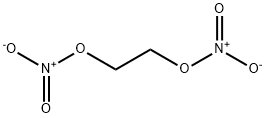Ethylene glycol dinitrate is a colorless to yellow, oily, odorless liquid. An explosive ingredient(60- 80%) in dynamite along with nitroglycerine(40- 20%). It may be detonated by mechanical shock, heat,or spontaneous chemical reaction. Molecularweight = 152.08; Specific gravity (H2O:1) = 1.49; Boilingpoint = 114- 116℃ (explodes); Freezing/Meltingpoint = -22.2℃; Vapor pressure = 0.05 mmHg at 20℃;Flash point = 215℃. Very slightly water soluble;solubility = 0.48%
Ethylene glycol dinitrate is a colorless to yellow,
oily, odorless liquid. An explosive ingredient (60%�80%)
in dynamite along with nitroglycerine (40%�20%). It may
be detonated by mechanical shock, heat, or spontaneous
chemical reaction
As an explosive usually mixed with
nitroglycerin (NG) in the manufacture of
dynamite
Explosive for mining and fuel industries. Additive to dynamite. Detection of hidden bombs by analysis of ambient air for EGDN.
A freezing-point depressant for
nitroglycerine.
Colorless to yellow, oily odorless liquid with a sweetish taste. Mp: -22°C; bp: explodes at 114°C. Density: 1.49 g cm-3. Soluble in water (23.3 g/L H2O) at 25°C). Very soluble in ethanol and in ether. Used as an explosive ingredient in dynamite along with nitroglycerine. Toxic; can penetrate the skin.
EGDN is explosive. Acts as a strong oxidizing agent. Heating to 114°C or above may cause a violent combustion or explosion producing toxic fumes (nitrogen oxides). May also decompose explosively from shock, friction or from a build-up of electrostatic charge that sparks suddenly to ground. Can begin a vigorous reaction that culminates in an explosion if mixed with reducing agents including hydrides, sulfides, and nitrides and numerous ordinary combustible materials. Reacts violently with Al, BP, cyanides, esters, PN2H, P, NaCN, SnCl2, sodium hypophosphite, and thiocyanates. Reacts with acids and with alkalis, including ammonia and amines. Must be stored in a cool, ventilated place, away from acute fire hazards and easily oxidized materials (Sax and Lewis, 1987 p.664).
Toxic by skin absorption.
EGDN causes vasodilation and
cardiac effects.
Can cause lowered
blood pressure leading to headache,
dizziness, and weakness. Used as an
explosive. When heated to decomposition it
emits toxic fumes of NOx. See also
NITRATES.
An explosive ingredient (60%�80%)
in dynamite along with nitroglycerine (40%�20%).
Although ethylene glycol dinitrate is an explosive in itself,
it is primarily used to lower the freezing/melting point of
nitroglycerin; together these compounds are the major constituents of commercial dynamite, cordite, and blastine gelatin. Occupational exposure generally involves a mixture of the two compounds. Ethylene glycol dinitrate is 160 times
more volatile than nitroglycerin.
If this chemical gets into the eyes, remove anycontact lenses at once and irrigate immediately for at least15 min, occasionally lifting upper and lower lids. Seek medical attention immediately. If this chemical contacts theskin, remove contaminated clothing and wash immediatelywith soap and water. Seek medical attention immediately. Ifthis chemical has been inhaled, remove from exposure,begin rescue breathing (using universal precautions,including resuscitation mask) if breathing has stopped andCPR if heart action has stopped. Transfer promptly to amedical facility. When this chemical has been swallowed,get medical attention. Give large quantities of water andinduce vomiting. Do not make an unconscious personvomit.Note to physician: Treat for methemoglobinemia.Spectrophotometry may be required for precise determination of levels of methemoglobinemia in urine
Explosive and Strong Oxidizer. Color Code—RedStripe: Flammability Hazard: Store separately from all otherflammable materials. Prior to working with this chemicalyou should be trained on its proper handling and storage.Before entering confined space where EGDN is present,check to make certain that explosive concentrations do notexist. EGDN is highly explosive and can detonate violentlyupon heating or impact. Store in tightly closed containers ina cool, well-ventilated area away from strong acids andalkalies. All sources of ignition are prohibited. Use nonsparking tools and equipment especially when opening orclosing containers. Use explosion-proof electrical equipment and fittings in all areas of handling, use, or manufacture. Where possible, automatically pump liquid fromdrums or other storage containers to process containers
UN0473 Substances, explosive, n.o.s., Hazard
Class: 1.1 A; Labels:1.1A-Explosive (with a mass explosion, hazard); A-Substances which are expected to mass
detonate very soon after fire reaches them, Technical Name
Required
Unstable; highly explosive. Heating may
cause violent combustion or explosion producing toxic
fumes (nitrogen oxides). May explosively detonate violently from heat above 200�℃, mechanical shock, friction,
impact or concussion. Not compatible with strong acids
and alkalies
